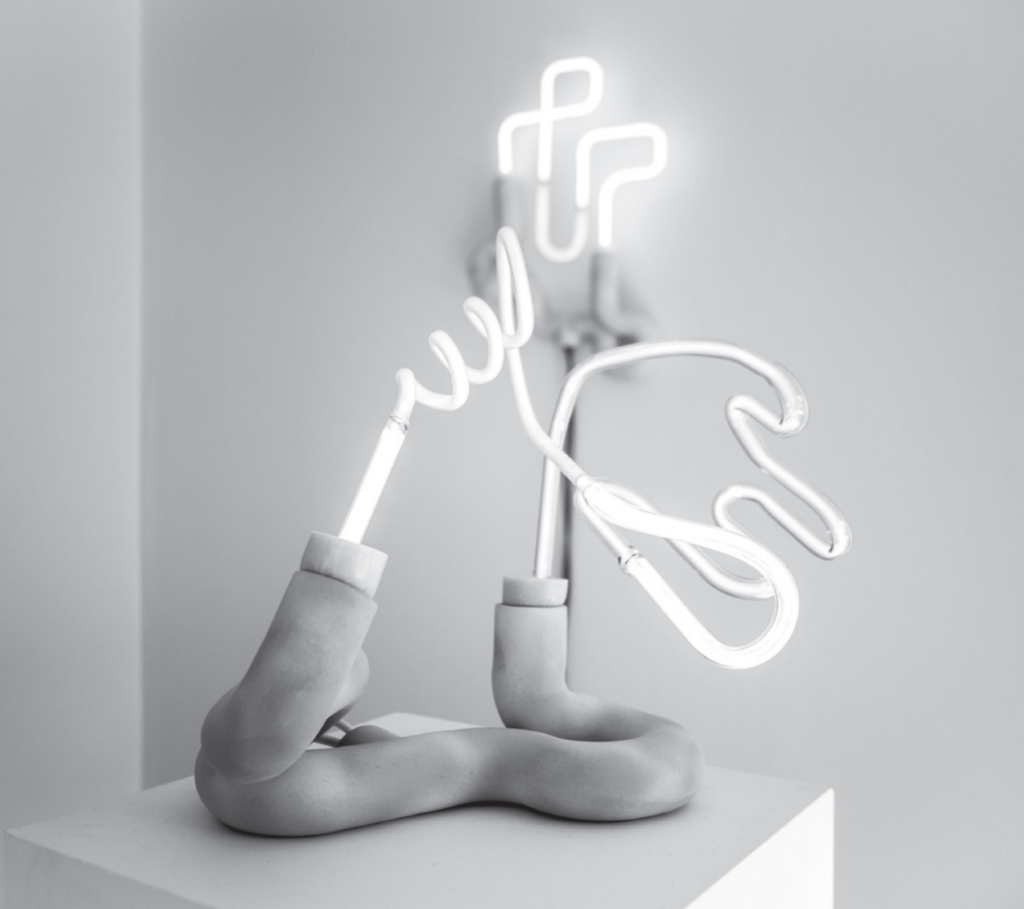Erin Smith: Live Noods
Review by Forest Lewis
Hair + Nails Gallery
Feb 23–Mar 30, 2017

Nood is the word at Erin Smith’s solo show at Hair and Nails gallery. What does it mean? Perhaps related to the word node and fratboy txt-speak for naked pics “n00d” and also noodles. Noodles are the shape du jour in this exhibit. The eponymous Live Noods neon centerpiece of the show would say “Live Noodles,” if the L and E hadn’t stopped functioning. “Live Noodles” refers to neon in general (all neon signs are live noodles) and to the show in particular while conjuring a Blade-Runner-style cityscape of the future where a ramen shop serves noodles that are alive/electrified.
But because of the non-functioning letters, “Live Noods” also suggests actual naked people. Neon has long been attached to a nightscape of urban decay. You’ll find that same rainy-night back-alley mood employed in Tracey Emin’s neon morning-after confessions and in Bruce Nauman’s animated neon boners. Like the neon sex signs of 1950s Manhattan, both artists are dealing in the illicit: sex sells. Following the arrow made by the “Live Noods” sign, however, takes you not to the burlesque but rather into a separate darkened room of the gallery where pieces of large black larval noodles litter shag carpeting over-lit by lurid blood-orange neon. Here one is meant to realize that the sex hinted at by the neon is not sexy but literal: sex as reproduction. This is perhaps the joke of the show, where XXX becomes XX/XY, and the draw of the nude is the unconscious drive of the biological node.
In any case I was not convinced. This scene setting, a kind of jokey body-horror, seems more like an afterthought, a means to lend ballast to what would otherwise be a show comprised of what appear to be clever desk lamps.
In the main room the prevailing mood is one of Beetlejuice-style whimsy. These pieces are mostly “table-top ceramic neons.” They are garish and cartoony and have silly titles: “Noods on Noods,” “Purple Solid,” “Power to the Purple,” etc. The soft glow from the lights plus the faint hum of the tubes create a curious environment, as if one were in some terrarium of the future full of the rustle of cybernetic plant life. These are the literal “Live Noods” where sex is of the rote biological variety: flower sex. The automatic, automating structure of a biological node, cast as art-object. For just as a flower produces scent, or a tree grows a branch, the artist makes a desk-lamp.
That feeling of works of artifice resulting from the original unthinking “fecund” could be explored further. As it is, in Live Noods, the automata of biology begins to seem more like the automation of the assembly line and so becomes derogatory to the work. The playfulness and whimsy, while allowing entry to the terrarium, is cloying and eager to please. In the end, I could not shake the desk lamp association. Because of the uniformity of forms on display—jacketed circuits that have been partially stripped to reveal the flowering guts—one has the impression of being on a showroom floor where husband and wife will buy quirky lamps to take away to their quirky home; it just seems so commercial. Now, obviously the art-object (usually) exists in an economy of exchange, and it is hardly fair to criticize a work for having a price tag, but even so, there is a difference between the decorative tchotchke and the art-object. One such helpful difference is the art-object’s ability to withstand scrutiny.
These works, while indicating strong directions of both form and meaning do not quite follow through on their initial promise and seem at last content in being mere décor; in other words, movable product.
